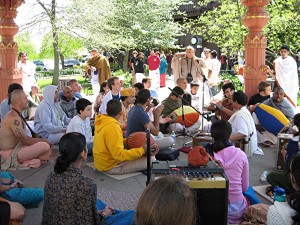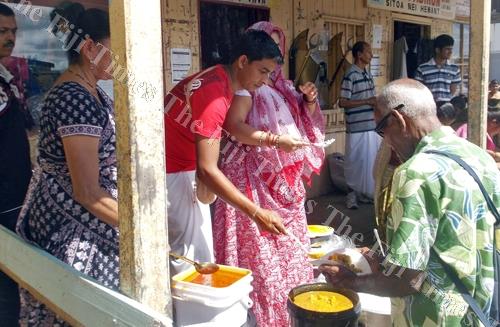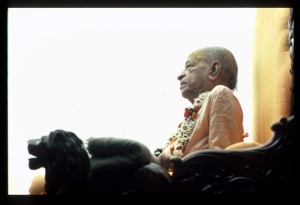Fourteen Years of Inspiration at New Vrindaban
May 9th- 11th, 2014
By Madhava Smullen

Bhajans at the Festival of Inspiration
“Aha! I’ve got a name for our festival!” Citralekha Dasi called to ISKCON Communications Director Anuttama Das from her office across the hall. And she told him what it was.
He grinned. “It’s perfect.”
The first annual Festival of Inspiration, held in 2001, quickly lived up to its name. It put New Vrindaban, which had recently rejoined ISKCON, back on the map as an important place of pilgrimage for North American devotees.
And it introduced a new breed of festival – the Krishna conscious vacation – now hugely popular in ISKCON. This was the first time that devotees from all over could come to hear dozens of senior teachers speak on a wide variety of spiritual, social and academic topics, from japa, interfaith outreach, and cow protection, to child-rearing, healthy marriages, art, and music.
Devotees were excited at the new possibilities, and the festival hit the ground running, drawing several hundred right away and reaching a peak attendance of 800 before settling at a comfortable 500 to 600 annually.
In 2003, early Srila Prabhupada disciple Malati Dasi began organizing the Festival, and brought it from strength to strength. Becoming part of the fabric of devotees’ lives in North America, it conjured up a raft of significant and magical moments over the years.
Who could forget, for instance, the first time comedians Yadunath Das and his wife Beth performed their pitch-perfect skits on ISKCON life?
“When I heard devotees laughing,” says Anuttama Das, “And realized that we were able to poke fun at ourselves – our shortcomings, our excesses, our cultural uniqueness — I felt really good that the Hare Krishnas had come of age.”
Then there was Madi Brinkmann’s “Burnt Laddu,” a heartrending drama about the experience of early gurukulis that opened ISKCON devotees up to understanding the plight of their youth.
The first Nama Yajna with Sacinandana Swami in 2008, Sunday morning dramas by Bhakti Marg Swami’s Toronto Players, Radhanath Swami’s Mother’s Day classes, the famous “Mystery Guest” and Ekendra Das’ hilarious Yama-Niyama Das Brahmachari routine all added their own inspirational and colorful touches to the event over the years, along with many others.
Festival of Inspiration’s approach was key, too. “For myself and those who came to assist me over the years, the mood was to serve Srila Prabhupada and his followers,” says Malati.
This included making sure presenters and attendees alike had comfortable lodgings and delicious prasadam, and that children got their own mini festival that helped them grow in Krishna consciousness in a safe environment, so that their parents could attend seminars worry-free.
“We wanted everyone to feel at home,” says Malati. “We wanted them to feel inspired and uplifted in their spiritual life, to make new friends who would become part of their devotee support system, and to want to come back again next year.”
After a decade of service, Malati is passing on the mantle of Festival of Inspiration this year to Vrindavana Das, who has a M.B.A. in marketing management and has already made Festival of Colors a success.
This year the festival, running from May 9th to 11th over Mother’s Day weekend, will be overflowing with the kind of rejuvenating spiritual nectar that devotees come to Festival of Inspiration year after year for.
Special 90-minute long Bhagavatam classes in the morning will include Prabhupada disciple Ramesvara Das on the early days of ISKCON, scholar Radhika Ramana Das on the Six Goswamis, and book distributor Vaisesika Das delivering his special brand of inspiration.
Twenty-six seminars and workshops will then be offered from 10:30am until 6:30pm on both Friday and Saturday.
Srila Prabhupada will be a major focus at this year’s festival, with both Hari Sauri and Srutakirti speaking on their experiences and realizations as the ISKCON Founder’s personal servants.
Ramesvara Das will give a seminar on the untold histories of the Bhaktivedanta Book Trust, speaking about how Srila Prabhupada built his movement through the BBT. And Malati Dasi will lead Srila Prabhupada — Our Eternal Master, in which 20 to 30 disciples will all recall their memories of their beloved guru.
Meanwhile others will present different strategies for spiritual and social success. In “Smart Devotees Finish Rich,” Krishna Gopal Das will provide a Krishna conscious approach to financial planning. And in “Strategic Planning for Life,” Anuttama Das will explain how to create your own strategic plan for achieving your spiritual and family priorities.
While their parents attend these and a host of other seminars on every imaginable topic, children will be absorbed in their own fun program, guided by experienced teachers Lilasuka and Sundari-Lila. They’ll participate in an art competition, educational programs based on the scriptures, Krishna Kids’ yoga, and even be entertained by a Krishna conscious clown.
The evenings will be full, too. As the sun sets, devotees will immerse themselves in a torrent of blissful kirtan with Vaisesika Das, Venezuelan musician Havi Das, Bengali kirtaniya Uttama Bhakta Das, and Namrock band leader Titiksava Karunika Das.
On Sunday at noon, Bhaktimarg Swami and his Toronto Players will bring the pastimes of the Lord alive with a thrilling production of “The Little Big Ramayana.” And at 1:30pm, the Festival will close with a delicious Sunday Feast of paneer, pakoras, sweet rice, gulabjamuns and more.
Throughout the festival, devotees will be comfortably accommodated at New Vrindaban’s motel-quality, newly renovated Lodge rooms and at nearby hotels. And they’ll enjoy three healthy, delicious prasadam meals prepared daily by world famous cook Shanka Das.
“It’s a great privilege to be able to serve so many devotees,” says organizer Vrindavana Das.
With many similar festivals like the Sadhu Sanga Retreat now competing for devotees’ attention, FOI will have to work harder to remain a contender, and it is certainly doing so.
Next year, for its 15th anniversary, organizers will invite an incredible roster of senior devotees and talent, from early residents of New Vrindaban, to some of Srila Prabhupada’s first disciples, to legendary kirtaniyas and Festival of Inspiration favorites.
The festival will reserve all hotels within a half hour’s drive from New Vrindaban so that 800 devotees can attend. And Vrindavana hopes to keep this increased attendance up in the future.
“The Festival of Inspiration was the biggest North American festival,” he says. “And we definitely want to take it to a new dimension again.”
For the latest updates, please visit http://www.festivalofinspiration.net/
 Also cultural presentations of the Hare Krishna movement in Budapest. Read more ›
Also cultural presentations of the Hare Krishna movement in Budapest. Read more ›  Also cultural presentations of the Hare Krishna movement in Budapest. Read more ›
Also cultural presentations of the Hare Krishna movement in Budapest. Read more ›  With Sivarama Swami. Szolnok is the county seat of Jász-Nagykun-Szolnok county in central Hungary. Its location on the banks of the Tisza river, at the heart of the Great Hungarian Plain, has made it an important cultural and economic crossroads for centuries.
With Sivarama Swami. Szolnok is the county seat of Jász-Nagykun-Szolnok county in central Hungary. Its location on the banks of the Tisza river, at the heart of the Great Hungarian Plain, has made it an important cultural and economic crossroads for centuries. 
 Devotee Sanjay Bhim Deo said the gesture was something they engaged themselves in every month for the purpose of sharing the spirit of love and unity. "This is an ongoing initiative for our organisation and it shows our love and care to everyone in society," he said.
Devotee Sanjay Bhim Deo said the gesture was something they engaged themselves in every month for the purpose of sharing the spirit of love and unity. "This is an ongoing initiative for our organisation and it shows our love and care to everyone in society," he said.  Giriraja Swami's nice answer!
Giriraja Swami's nice answer! 





































 Nice ceremony!
Nice ceremony!  Francis Xavier Clooney, S.J., is an American Jesuit Roman Catholic priest and scholar in the teachings of Hinduism. He is currently a professor at Harvard Divinity School in Cambridge, Massachusetts. "Why be part of an institution? Especially in times of disagreement (or embarrassment), I've asked myself this question and have, on more than one occasion, struggled to find an answer."
Francis Xavier Clooney, S.J., is an American Jesuit Roman Catholic priest and scholar in the teachings of Hinduism. He is currently a professor at Harvard Divinity School in Cambridge, Massachusetts. "Why be part of an institution? Especially in times of disagreement (or embarrassment), I've asked myself this question and have, on more than one occasion, struggled to find an answer."  With Sivarama Swami.
With Sivarama Swami. 
 Chandan Yatra falls on Akshaya Tritiya. Both the Sun and Moon are exalted on this day. Some other important events that took place are:
1) The Appearance of Lord Parasuram.
2) The Appearance of the Ganges River.
3) Sudama brought poha to Krsna!
4) Khir- Chor -Gopinath Pastime stealing of the sweet rice done by Gopinath.
5) Krishna presented Draupadi with the Akshaya Patra- pot that never lacked..
6) Ganesh Ji started writing Maha Bharat!
7) They start building the Rath Carts in Puri!
8) They open Char Dham in the mountains up for travel.
9) Treta Yuga began on this day.
10)The Beginning of Chandan Yatra commences because the Sun is right over head for 21 days, so devoted souls keep the Lord cool by applying sandal wood paste
Therefore anything undertaken on this day (even material with eventual desire to dovetail in Krsna's service) turns out auspicious.
Chandan Yatra falls on Akshaya Tritiya. Both the Sun and Moon are exalted on this day. Some other important events that took place are:
1) The Appearance of Lord Parasuram.
2) The Appearance of the Ganges River.
3) Sudama brought poha to Krsna!
4) Khir- Chor -Gopinath Pastime stealing of the sweet rice done by Gopinath.
5) Krishna presented Draupadi with the Akshaya Patra- pot that never lacked..
6) Ganesh Ji started writing Maha Bharat!
7) They start building the Rath Carts in Puri!
8) They open Char Dham in the mountains up for travel.
9) Treta Yuga began on this day.
10)The Beginning of Chandan Yatra commences because the Sun is right over head for 21 days, so devoted souls keep the Lord cool by applying sandal wood paste
Therefore anything undertaken on this day (even material with eventual desire to dovetail in Krsna's service) turns out auspicious.  "If Indian young men join me, I am immediately ready for this traveling, touring from village to village and town to town. However, my foreign disciples have the language defect - they can't speak the village language. Otherwise I would have started this program long ago. If some young men like you would join me, then along with some foreign disciples I can immediately take up this program. If you are very eager, please get hold of at least half a dozen young men like you, then with another half dozen foreign disciples I can immediately take up this program and tour village to village and town to town. It will be very, very effective. I know that."
(Srila Prabhupada's letter to Panjabi Premananda, a young Indian man who had suggested to him that ISKCON organize a padayatra under Prabhupada's direction. April 16, 1976)
"If Indian young men join me, I am immediately ready for this traveling, touring from village to village and town to town. However, my foreign disciples have the language defect - they can't speak the village language. Otherwise I would have started this program long ago. If some young men like you would join me, then along with some foreign disciples I can immediately take up this program. If you are very eager, please get hold of at least half a dozen young men like you, then with another half dozen foreign disciples I can immediately take up this program and tour village to village and town to town. It will be very, very effective. I know that."
(Srila Prabhupada's letter to Panjabi Premananda, a young Indian man who had suggested to him that ISKCON organize a padayatra under Prabhupada's direction. April 16, 1976) 



